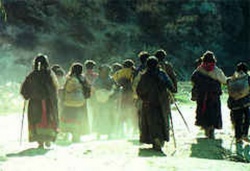The Nyingma Tantras Research Database
I. Description of the project
Co-Directors: David Germano and Robert Mayer.
Editor of Atiyoga section: David Germano.
Editor of Anuyoga section: Not assigned, but Jake Dalton currently editing the files.
Editor of Mahðyoga section: Robert Mayer and Nathaniel Garson.
The Nyingma (rnying ma) tradition of Tibetan Buddhism has its roots in the eighth-ninth century Imperial period of Tibetan history in the so-called "early transmission" of Buddhism into Tibet from India and other countries. It was subsequently displaced by new Buddhist lineages emerging in the "later transmission" dating to the late tenth century onwards, which primarily took place from India and followed a decentralized period in Tibet after the Empire disintegrated. In addition to genuinely ancient textual traditions the Nyingmas possessed from prior to the tenth century, from at least the late tenth century onwards they also produced ongoing - and largely tantric - textual revelations known as "treasures" (gter ma), while the new Buddhist lineages instead focused on producing translations of Indic manuscripts. When the latter codified their work into the great scriptural collections of translations known as the Kangyur (bka' 'gyur) and Tengyur (bstan 'gyur), the Nyingma's tantric literature was largely excluded due to suspicions as to its authenticity. While in some cases certainly the new treasures were simply new Tibetan compositions masquerading as translations of ancient Indic texts, in other cases it is clear that the texts incorporated genuinely ancient materials, albeit in at times complex ways that remain to be determined.
Partially in response to this marginalization of their own literature, though there appear to have been earlier redactions as well, the Nyingmas collected their older, pre-fifteenth century tantric traditions into their own unique multi-volume scriptural canon, which came to be known as "The Collected Tantras of the Nyingmas" (rnying ma rgyud 'bum, NGB). The collection exists in various editions that vary in actual contents as well as organization, though they share a basic core of texts. For example, the length ranges from eleven to forty six volumes. In addition, some of the texts found in these editions are also located in other canonical collections. These collections are of inestimable value since not only do they contain otherwise translations of now lost Indic texts that date back to the eighth century, but they also contain literature that probably emerged in Tibet in the very obscure yet central eighth to tenth century period, as well as highly creative literature that reflects the Nyingmas startling innovative adaptation of Indic Buddhism in the eleventh to fourteenth centuries. The collections tend to be divided into three structure, reflecting the three main textual traditions of the Nyingma tantras: Atiyoga, Anuyoga, and Mahðyoga. Despite this importance, until the current project, the NGB has been largely ignored by contemporary scholarship, and only one edition has previously even been indexed.
The fundamental initial aim of the project is thus to index and cross reference each of the various editions of the NGB, indexing them with each other and also any other editions of the texts they contain, whether extant in stand alone editions or in separate collections. There will be a separate electronic index for each edition of the NGB, with each entry cross referenced with the other editions of NGB and also any other editions of any given text contained within it. Each edition will have a unique two letter combination used to identify with it based on the Tibetan name of the edition (using the general principle of the root letters of the first two syllables). These two letter markers will be used to give each text in each edition a unique identification number based on its sequence within the overall collection of that edition. These numbers will also indicate what physical volume of an edition a given text is in, what sequence it is within that volume, and what its overall pagination is within that volume.
Eventually we will then create a master index that is comprehensive for all editions of NGB which will use our own principles of organization. However this will wait until all initial indexes have been completed, and will be unstable for a number of years as further research determines how valid proposed principles of organization are. We may want to begin by taking the longest edition as our basis, and simply adding all other unique texts from other collections within the section it seems to belong to, i.e. either Atiyoga, Anuyoga or Mahayoga. We can then slowly begin to organize the texts internally in what we see as the most optimal sequence. These will be assigned NGB numbers. Thus the reference numbers for the individual indexes will be what is used for reference purposes in scholarship for the coming years.
Eventually all texts will be translated into European languages, as well as analyzed chapter by chapter into European languages. Additionally all texts will be included in their original Tibetan both with machine readable typed in versions and digitized images of the original manuscripts. Thus the project will not only greatly facilitate Tibetological scholarship, but will also eventually be accessible to the broader reading public. Given the importance of the materials included in the NGB, and their intrinsic interest as highly creative Buddhist tantric traditions, we anticipate that eventually the project will be used widely by a wide variety of individuals including undergraduates.
send email inquiries to: David Germano
Department of Religious Studies
Center for South Asian Studies
University of Virginia
Charlottesville, VA 22903

